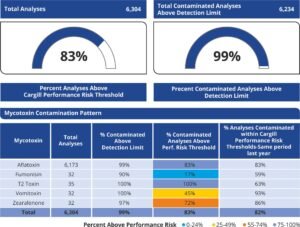January – May 2025
Mycotoxins are secondary metabolites produced by fungi such as Aspergillus, Fusarium, and Penicillium-pose a persistent and evolving threat to feed and food safety globally. In India, the warm, humid climate, combined with faulty agricultural and storage practices, creates a conducive environment for mycotoxin contamination, especially in key feed ingredients like maize, rice by products, corn by products and groundnut meal. Mycotoxins are an invisible but serious threat to animal productivity and profitability. Through its rolling survey initiative, Cargill empowers feed manufacturers, integrators, and farmers with actionable intelligence to proactively mitigate risk. In a changing climate and evolving agricultural landscape, such continuous monitoring is not just an option-but a necessity-for ensuring feed safety and livestock well-being in India.
Key highlights of Mycotoxin Survey
- Total 6304 analysis has been conducted out of which 99% were contaminated with mycotoxins & 83% were contaminated above threshold risk.
- India comes in severe high risk zone, where 75% – 100% analysed samples were above performance risk level for mycotoxin contamination.
- Aflatoxin is most prevalent mycotoxin followed by T2, DON (Vomitoxin), Zearalenone, and Fumonisin, which all can reduce performance and increase disease incidence in poultry farm operations. They exert their effects through alteration in nutrient content, absorption, and metabolism. Changes in the endocrine function: and suppression of the immune system.
- Certain ingredients consistently exhibit higher susceptibility to specific mycotoxins. Highly contaminated ingredients are: De oiled Rice Bran (DORB), Dried Distillers Grain Soluble (DDGS) specifically corn DDGS and Pea Nut Meal. These ingredients should be used judiciously with precautions. Regular mycotoxin analysis should be conducted to know contamination levels.
- Moderately contaminated ingredients are: Corn, Soyabean Meal (SBM) and Broken Rice. Corn is major constitute of poultry feed & being used more than 50%, Therefore, low level of contamination in corn could be highly harmful for bird.
- A major concern identified through the survey is the frequent co-occurrence of multiple mycotoxins in single samples. For example, combinations of aflatoxin, fumonisin, and DON are increasingly common in raw materials. This synergistic toxicity exacerbates the risk to animal health, often leading to immunosuppression, reduced feed intake, poor performance, and reproductive issues. Multiple mycotoxin co occurence was 97% in given time period.
